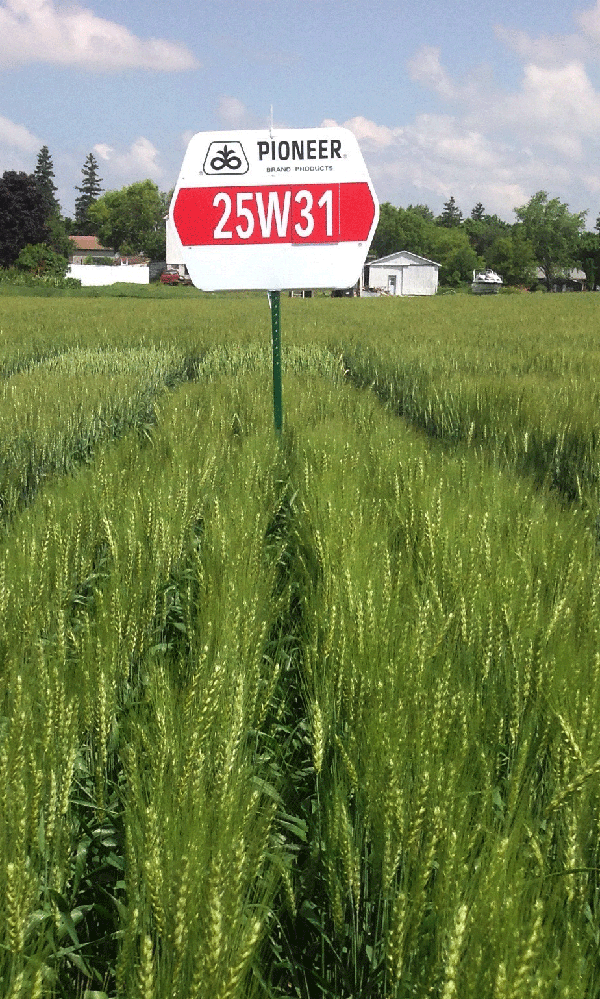Niche wheat market development
A TANGIBLE BENEFIT OF PBR
IT’S BEEN LESS than a year since the Plant Breeders’ Rights Act (PBR91) was updated at the end of February 2015. This move, long awaited by Canadian and international seed companies as well as crop farmers, puts Canada on the same footing as other countries belonging to the Union for the Protection of New Plant Varieties (UPOV91) and unlocks doors for the development of new and improved seed varieties in Canada and beyond. Farmers will benefit from a wider seed selection — which means a boost in global competitiveness for them and for Canada as a whole.
PHOTO: THE VERY FIRST VARIETY TO BE PROTECTED UNDER PBR 91 IS CALLED 25W31, A SOFT WHITE WINTER WHEAT DEVELOPED BY DUPONT PIONEER.

The need for PBR was simple. Before the amendments were made, companies were reluctant to invest in breeding new crop varieties in Canada because their intellectual property rights were not protected adequately. For their part, international breeders were unwilling to send their superior varieties to Canada, even though they saw market potential. Now, all that has changed.
NICHE WHEAT
Crosby Devitt, executive director at the Canadian Seed Trade Association (CSTA), says that while PBR is meant for all crop varieties, the greatest impact will likely be seen in wheat and other cereals.
“It’s always a challenge for anyone to get a return back on investment if a market is small, and that’s the case with niche wheat varieties,” he explains. “Getting a return back on the breeding work was difficult, but with the new PBR 91 protection, with clear rules about the sale of seed from those varieties, the situation is very different.”
Soft white winter wheat is a perfect example of a niche market where growers stand to gain from the new protections provided by PBR 91. Soft white is used primarily in the breakfast cereal, baked goods, and pastry market and accounts for a very small percentage of the winter wheat that’s grown in Eastern Canada. It has provided a healthy premium for growers in recent years, but being able to plant improved soft white winter wheat varieties, with better yields and other improved agronomic characteristics, will make the profits better and the market more sustainable.
With PBR 91 protections, those varieties are starting to appear. The very first variety to be protected under PBR 91 is called 25W31, a soft white winter wheat developed by DuPont Pioneer.
Dave Harwood, technical services manager at DuPont Pioneer, says that PBR 91 protections, such as the harvested material provisions, extend the responsibility of the grain purchaser of knowing if the seed used to produce the commodity was legally obtained.
“This should drive increased use of certified seed and, therefore, compensation for the investment made by the developer,” Harwood says, “which in turn should make variety developers more willing to invest in niche opportunities.”
“Both domestic and international product developers are more likely to introduce new varieties here that will give growers access to genetic progress for productivity and quality,” Harwood adds. “This is great for Canadian farmers, but it goes beyond that. It benefits the entire value chain. Grain handlers, processors, and exporters all benefit when Canadian growers are more productive, with products in higher demand because of their enhanced end-use characteristics.”
INTERNATIONAL MARKETS
Devitt agrees that PBR 91 will mean more new varieties will be developed for and tested within Canada.
“Only four per cent of global wheat is presently grown in Canada, so there are a lot of genetics that could be tested here,” he notes.
Devitt points out one of the first global seed development partnerships to be announced after PBR 91 was the opening of Limagrain Cereals Research Canada in Winnipeg in July 2015. This centre is supported through a partnership between Canadian company Canterra Seeds and international seed developer Limagrain. The two firms state that the centre will deliver significant benefits to Canadian farmers through harnessing the best research, the most innovative technologies, and the best germplasm in the world.
While Harwood is pleased about the enhanced intellectual property protections provided for plant genetics developers under PBR 91 — and sees it as an important positive step for the entire industry — he’d like to see more change. “If constraints on innovation by plant variety developers that result from variety registration were removed, we’d see additional enhancements to the value chain,” he notes. “If the government eliminated variety registration as a requirement for commercialization of innovations in major field crops, it would speed up the creation and delivery of value-added innovations.”
ADDITIONAL RESOURCES
In August, the CSTA launched a PBR variety database, created with the assistance of the Canadian Food Inspection’s Variety Registration Office and the PBR Office. The database assists stakeholders all along the value chain to easily identify PBR protection on crop varieties for sale in Canada, and can be searched by crop, variety name, and type of PBR protection: http://cdnseed.org/library/ crop-kinds-database/.
CSTA’s PBR website includes information on previous and current legislative protection levels: www.PBRfacts.ca. •







